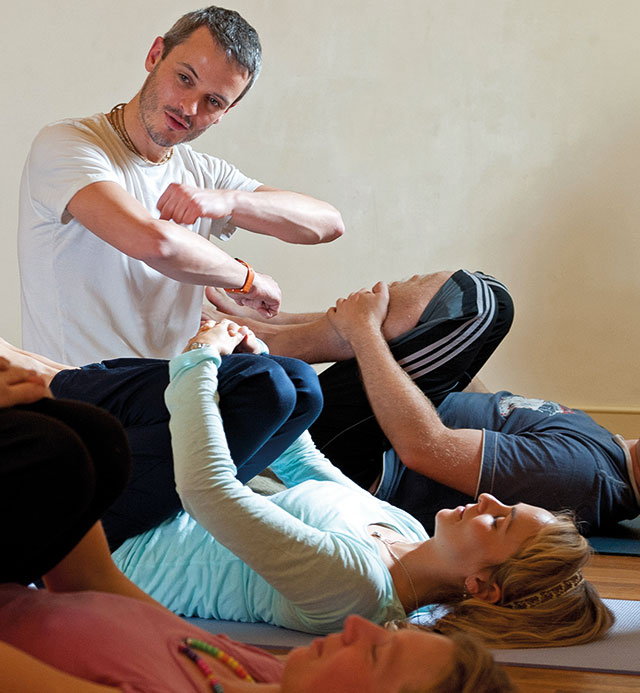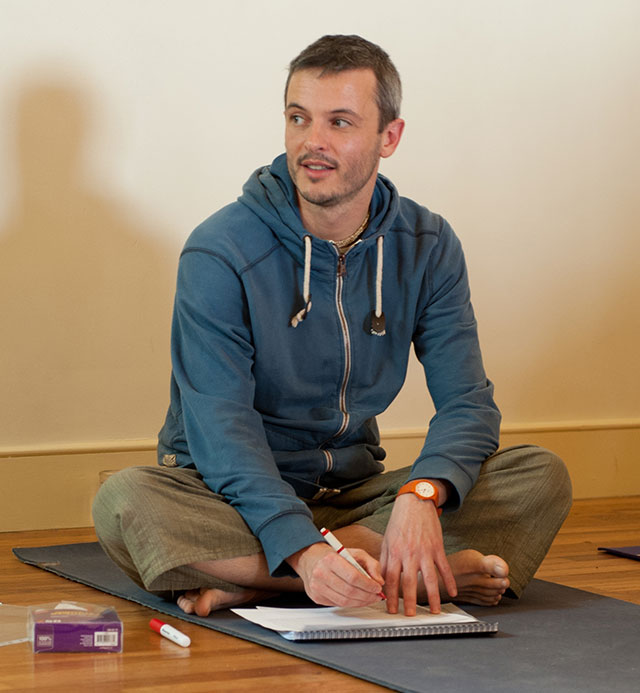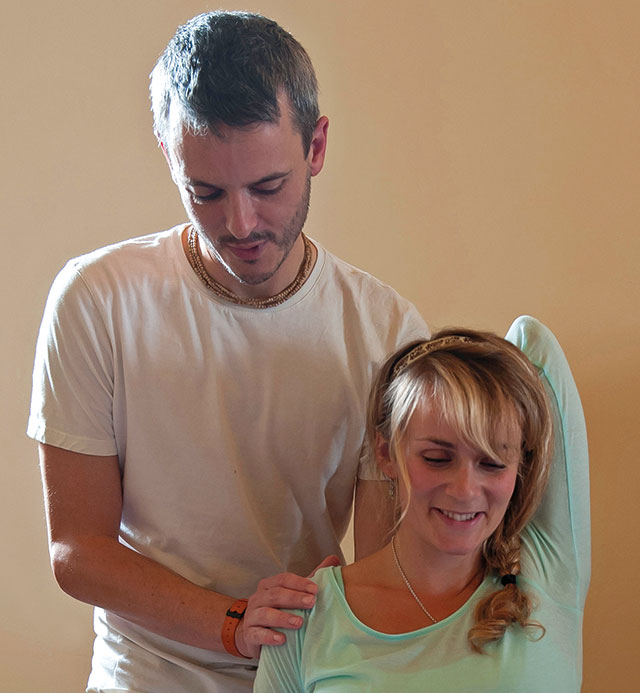By James Russell.
‘A little yoga practice in the morning… and the rest of the day is your friend.’ Proverb.
Yoga is the stilling of the waves of the mind – ‘yoga chitta vritti nirodha’ (YS 1.2.) A wise yogi once observed that the mind is like a drunken monkey that has been bitten on its tail. Assuaging such a monkey mind is no small task and like all great endeavours requires patience and practice.
Patanjali identifies ‘practice’ as the repeated effort to attain tranquility:
“Exertion to acquire Sthiti – a tranquil state of mind, devoid of fluctuations is called practice.” – Patanjali 1:13

Practising yoga is a bit like learning a musical instrument. When we first begin to practice: maybe some postures, or meditation, the instrument can make a terrible, discordant noise. But then, if we continue, we discover first how to tune the instrument and then in time we learn the notes, scales and chords. With perseverance we are able to make sweet sounds and beautiful music.
Attending a weekly class is a great way to begin a yoga practice but it is when we begin to regularly practice on our own at home that we begin to make real progress. The first step is to make a little time and space in our daily routine to begin our practice:
“In the beginning you have to make room for yoga in your daily life, and give it the place it deserves. But after some time, yoga itself will pull you up by the hair and make you do it.” (Vanda Scaravelli)
Daily practice requires will-power and discipline. A vital quality to develop is ‘tapas.‘ Tapas comes from the sanskrit root word ‘tap’ meaning ‘heat.’ In the context of yoga practice, it is our inner energy: the fire that burns within that is the fuel on our journey towards self realisation.
When we transcend our own, self-imposed limitations in the pursuit of a higher goal then this is tapas. The idea is that we build inner discipline: we channel our desire for self development into a tangible practice. For example, if I resolve that I’m going to get up every morning at 6am and meditate for 20 minutes, at some point my mind or body, or both will rebel: its much easier to stay in bed and rest. However, when I override these impulses, when I get up and do the practice anyway – this is tapas.
Tapas is a fire that burns and cleanses us of sloth, ineptitude and negativity. Many Natha yogis in India make tapas their main practice with some performing extreme feats of endurance in the pursuit of siddhis – powers. I like to think of tapas as the development of will-power. When we build will-power we become stronger and more powerful. In time, we can achieve things that may once have seemed impossible.
Tapas is advocated by Patanjali in his Kriya yoga and is also a component of Niyama, the second limb of Patanjali’s Ashtanga, (eight-limbed) yoga.
It can initially be difficult developing the kind of tapas required to practice each day. In the Bhagavad Gita, Arjuna expresses his frustration that the mind is:
‘as hard to control as the raging wind.’ (B.G. 6:34)
I find it encouraging that even Arjuna, who is such an advanced yogi that he is a close personal friend of Krishna, finds it difficult to practice. Is it any wonder that the rest of us may sometimes find it a little tricky?
However, Krishna reassures Anjuna that: “through repeated practice – ‘abhyasa’ and non-attachment – ‘vairagya’, the mind can be controlled.” (The same instruction is also found in Patanjali Y.S. 1:12.)
There are times when getting up early to practice is a struggle. Sometimes, in the middle of winter, when its cold and dark and the body is longing for that extra hour in bed, it can be really challenging. But part of committing to daily practice is to rise to the challenge: to do the practice anyway; drag yourself out of bed regardless… once you get on your mat and begin, you’ve already succeeded. Anything that happens next is an added bonus!
Other times, you will spring out of bed and be ready to start early. You may even find yourself looking forward to your practice the night before. These are the ups and downs of a daily practice. The trick is to keep up with the practice (abhyasa) regardless of the extremes (vairagya.)
‘Practice becomes firmly grounded when well attended to for a long time, without break and in all earnestness.” (Patanjali, Y.S. 1:14)
Yoga practice is most effective when practised regularly and consistently, ideally over many years. After a while the practice becomes an essential part of the daily routine, a bit like having a shower or brushing teeth. In our busy, fast-paced and often high-pressured lives, a regular yoga practice can be a boundless source of strength, inspiration and refuge. Even five or ten minutes yoga practice can radically transform the rest of the day and enhance the quality of the relationship we have with our self and also those we interact with. Yoga practice is a holistic tool that nourishes and supports everything else that we do in life.
At first the idea of practising at home, beyond the guidance and encouragement of a teacher may seem a little daunting, so here are a few simple suggestions that may help to develop a regular home practice, or to enhance an existing practice:
Make an intention: Take time to make an intention (Sankalpa) to practice. By regularly affirming a sankalpa, our intention is more easily made manifest within our lives. This could take the form of writing down your resolution or repeating it to yourself at the beginning of your practice.
Start small: even 5 or 10 minutes focused practice each day can considerably enhance the rest of your day. Today’s tiny acorn is tomorrow’s mighty oak. By taking small steps initially, given time and nourishment, your practice is sure to grow in duration and intensity.
Be realistic: if you decide that you’re going to practice for 2 hours a day, 6 days a week: check whether this is achievable or sustainable. If you set yourself an unrealistic schedule then you may become disappointed or frustrated with yourself. Its more effective to practice for 3 days a week consistently over a long period than to sporadically practice for 6 days a week.
Space: make a space in your home where you can practice: ideally somewhere clean and quiet. If you are devotionally minded you may find that creating a shrine to a Guru or your chosen Deity will help to create an atmosphere conducive to yoga practice. If you’re not the devotional type then some flowers, a houseplant or crystals can help create the right atmosphere.
Time of day: most practitioners find that morning or early evening works best. The ideal time for yoga practice is widely regarded as early in the morning. This is also the time when the stomach has been empty for a long time, so a good time for kriya, asana and pranayama practice. However early morning may not be suitable for everyone: for example parents with small children.
Regularity: if possible, choose a time each day and stick with the same time. Most practitioners rest for at least one day each week.
Preparation: I find that when I practice each morning, it helps if beforehand I have a cup of herbal tea and sit quietly for about 5 to 10 minutes. This is also a good time to read an inspiring book on yoga such as Patanjali’s yoga sutra.
What to practice: find a practice that suits your temperament. Practice can therefore include any one, or any combination of: kriya, asana, pranayama, meditation, mantra & nidra. Most people find that practising what they have learnt with their teacher will help them to progress. Its useful to have a regular practice sequence so that its possible to gauge progress. However it is also important to be flexible with that sequence. Each day is different and its helpful to consider factors such as energy levels, health, amount of time available, the weather and season.
Compassion: be kind to yourself. Rather than being judgemental in your practice, its more nurturing to develop an attitude of self-acceptance and forgiveness. If you do lapse from time to time, don’t get caught in the self negativity of feeling guilty.
Patience: yoga is a life-time practice. We want to be still practising in our 80s and 90s.
Have fun: enjoy your practice! If your practice becomes a labour or chore then its unlikely that you’ll want to continue with it. Find a practice that you enjoy and embrace that feeling so that you want to repeat it each day.
Practice heroically & diligently and, over time, your practice will bestow innumerable benefits on yourself and others around you.
Namaste.

Lorem ipsum dolor sit amet, consectetur adipiscing elit, sed do eiusmod tempor incididunt ut labore et dolore magna aliqua.

Lorem ipsum dolor sit amet, consectetur adipiscing elit, sed do eiusmod tempor incididunt ut labore et dolore magna aliqua.